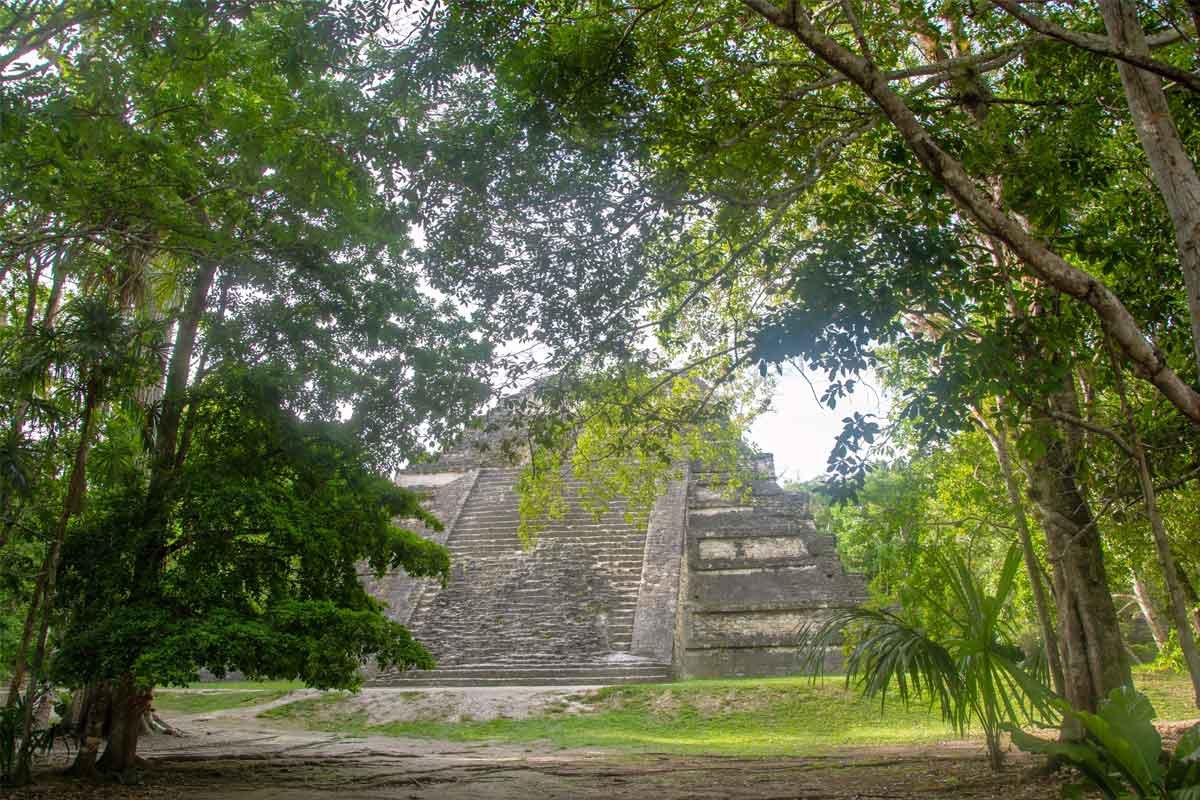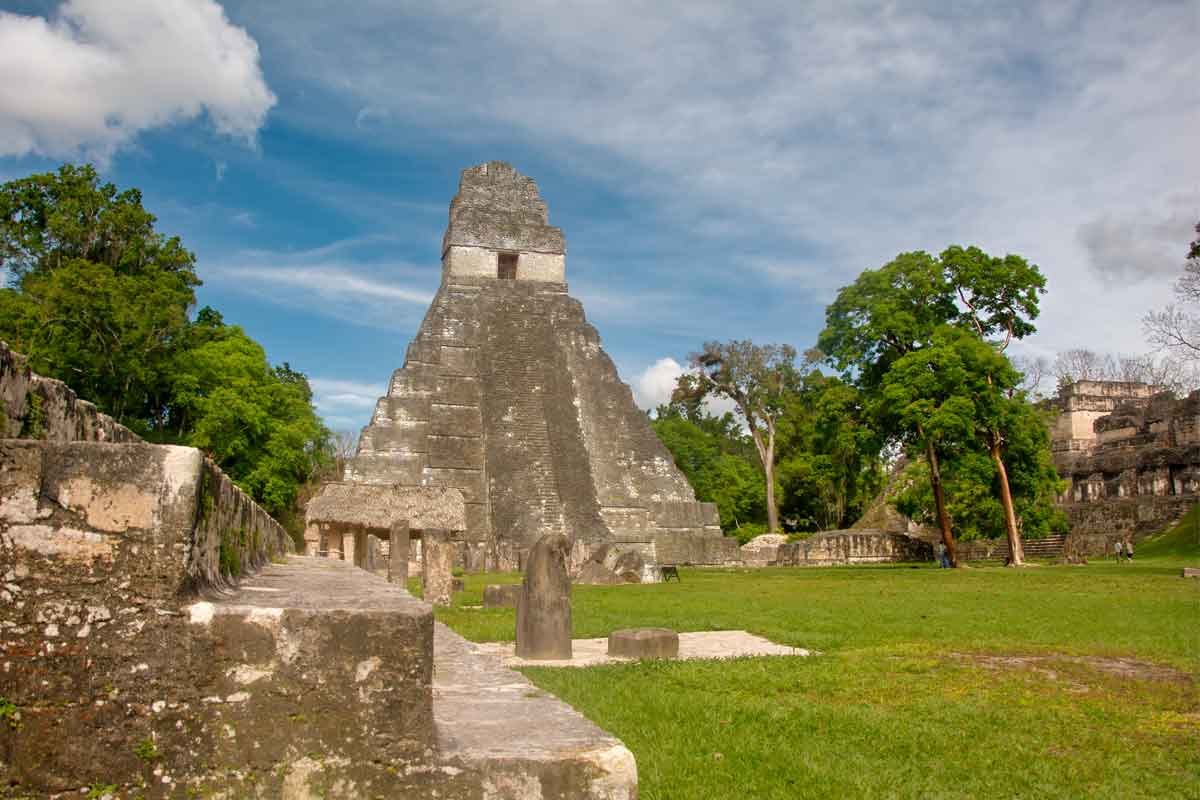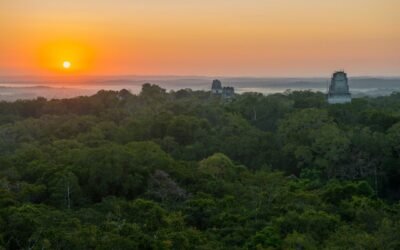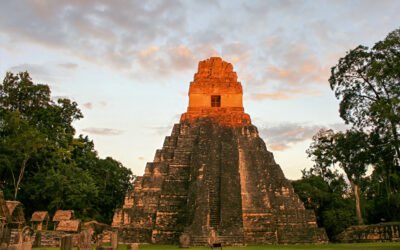Tikal is a remarkable testament to the Maya civilization’s advanced understanding of the cosmos. The design of Tikal’s temples shows how the ancient Mayans intertwined their daily lives with celestial events. These structures served as observatories, allowing the Mayans to track the movements of stars and planets. This connection to the heavens influenced their 260-day calendar, which guided agricultural cycles and societal decisions.
Modern science has validated the astronomical significance of Tikal’s architecture. Observatories here were tools for tracking celestial bodies and symbols of power. Rulers linked their lineage to the stars, embedding astronomy into governance and culture. As you explore Tikal, you uncover the brilliance of Mayan Astronomy at Tikal, a legacy that continues to inspire. Tours to Tikal offer a unique glimpse into this ancient wisdom, making it a must-visit destination. Whether traveling from Guatemala City to Tikal Tours or using a Tikal Travel Guide, this Tikal Unesco Site promises an unforgettable journey.
Key Takeaways
- Tikal’s temples were used to watch the sky and stars.
- The Maya created a 260-day calendar by studying the heavens.
- This calendar helped them farm and make crucial decisions.
- Buildings like the E Groups lined up with solstices and equinoxes.
- This shows how closely the Maya connected with the universe.
- Tikal is a UNESCO site that is important to history.
- It helps people today learn about this amazing ancient culture.
- The Mayans mixed science, religion, and daily life in innovative ways.
- They teach us to respect nature and follow its cycles.
The Historical and Cultural Context of Tikal
Tikal was a Center of the Ancient Mayan Civilization
Tikal, also known as Yax Mutal, was one of the most influential cities in the ancient Mayan civilization. Its history stretches back to 1000 B.C. but peaked between 200 and 900 A.D. During this time, Tikal’s population grew from 45,000 to 62,000. This growth required advanced urban planning. The Maya developed sophisticated water management systems to sustain their large population. These systems ensured a steady water supply, even during dry seasons.
Tikal’s location made it a vital trade hub. It connected other Mayan cities and regions, facilitating the exchange of goods like obsidian, jade, ceramics, and textiles. The city’s prosperity depended on controlling these trade networks, which extended into modern-day Mexico and Honduras. Tikal’s cultural and political dominance surpassed other Mayan centers like El Mirador. Its towering temples and ceremonial plazas symbolized its power and influence within the Maya world.
The Role of Astronomy in Mayan Society
Astronomy was central to Maya culture, shaping their daily lives and spiritual practices. At Tikal, the Mayans constructed observatories to study celestial movements. They used this knowledge to create a 260-day calendar that guided agricultural and ritual activities. The alignment of Tikal’s temples with celestial events highlights the deep connection between astronomy and architecture.
The Mayans integrated astronomy into agriculture. Planting and harvesting rituals were scheduled based on the positions of the sun, moon, and stars. Ceremonies were performed to honor the gods during these critical times, reinforcing the link between the cosmos and agriculture. The ceremonial centers at Tikal were designed to host these gatherings, demonstrating how astronomy influenced the city’s physical layout.
Rediscovery of Tikal Mayan Ruins and Their Modern Importance
The rediscovery of Tikal in the mid-19th century revealed its grandeur. Archaeologists uncovered its towering temples, plazas, and artifacts, shedding light on the Maya’s social, political, and spiritual life. Today, Tikal is a UNESCO World Heritage site recognized for its cultural and architectural significance.
Preservation efforts at Tikal continue to provide valuable insights. Studies of skeletal remains reveal details about the Mayans’ health and diet. Analysis of artifacts and building patterns uncovers information about trade networks, social hierarchies, and resource management. Tikal’s grand temples and public spaces also highlight its role as a center for governance and ceremonies. Visiting Tikal allows you to witness the Mayans’ legacy and remarkable achievements.
Astronomical Alignments in Tikal’s Architecture
 Lost World – Tikal
Lost World – Tikal
Solstices and Equinoxes in Tikal’s Design
Tikal’s architecture reflects the ancient Maya’s deep understanding of celestial cycles. The E Groups, a unique architectural feature found in Tikal and other Maya sites, were designed to observe significant astronomical events. These structures allowed the Maya to track the sun’s position during solstices and quarter-days, two days before and after the equinoxes. Unlike Western astronomy, the Maya did not focus on equinoxes as specific events. Instead, they emphasized quarter-days, which aligned with their calendrical system and agricultural needs. This alignment highlights the practical and spiritual importance of Maya astronomy at Tikal.
The E Groups served as observatories for solstitial events, marking the extremes of the sun’s path. These alignments were scientific tools and symbols of the Mayans’ connection to the cosmos. By observing the movement of the stars and the sun, the Mayans could plan agricultural activities and perform rituals that honored their gods. This integration of astronomy into daily life demonstrates the advanced Maya knowledge embedded in Tikal’s design.
Planetary Movements and Temple Alignments
The temples at Tikal showcase the Mayans’ fascination with planetary movements. The twin pyramids and stelae, with symmetrical arrangements aligning with celestial events, commemorate the K’atun, a 20-year cycle in the Mayan calendar. These structures were visually stunning and functional, serving as landmarks for observing the heavens. Processional routes within Tikal were oriented toward specific celestial events, reinforcing the connection between architecture and the sky.
The pyramid’s step-like construction reflects the Mayans’ interpretation of the firmament. These designs symbolized their belief in a layered universe, with each step representing a different level of existence. The alignment of these temples with celestial bodies underscores the Mayans’ devotion to cosmology and their ability to integrate it into urban planning. Tikal Mayan ruins stand as a testament to this remarkable achievement.
The E-Groups and Their Astronomical Purpose
The E-Groups at Tikal are among the most fascinating astronomical marvels of the ancient Maya. These complexes, first identified at Uaxactun, consist of three structures that mark the eastern horizon. The Mayans used them to track the sun’s position during solstices and equinoxes. Excavations in the 1930s confirmed their use as observatories for naked-eye astronomy, showcasing the Mayans’ sophisticated understanding of celestial phenomena.
While the E-Groups had a practical purpose, they also held ritualistic significance. The Mayans used these structures to perform ceremonies aligned with the solar calendar. This dual purpose highlights the integration of Mayan astronomy into spiritual and agricultural practices. Visiting Tikal National Park today, you can witness how these structures reflect the ancient Mayans’ ability to blend science, religion, and daily life seamlessly.
Mayan Astronomy at Tikal
The Mayan Calendar and Its Precision
The Mayan calendar is one of the most remarkable achievements of the Maya civilization. At Tikal, the construction of observatories highlights the Mayans’ dedication to studying celestial movements. These structures allowed them to develop a calendar system with extraordinary accuracy. The Long Count calendar, for example, tracked time with minimal error, showcasing their advanced understanding of timekeeping.
- Observatories at Tikal were designed to monitor celestial events, contributing to the calendar’s precision.
- The Maya correlated significant historical events with specific dates in their calendar, demonstrating its practical application.
- Their ability to track celestial events without modern tools rivals the precision of contemporary astronomical instruments.
The accuracy of the Maya calendar continues to amaze modern researchers. Their observations of the sun, moon, and planets influenced their daily lives and long-term planning.
Astronomy in Mayan Spiritual and Ceremonial Life
Astronomy profoundly influenced the spiritual practices of the Maya at Tikal. Observatories served as essential tools for astrological purposes. The Maya used their 260-day calendar to determine planting seasons and predict destinies. This calendar reflected their belief in the interconnectedness of the cosmos and daily life.
Rituals at Tikal are often aligned with celestial events. For example, agricultural ceremonies were scheduled based on the positions of the sun and stars. The design of ceremonial centers mirrored these cosmic patterns, reinforcing the connection between the heavens and spiritual practices. Temples symbolized sacred mountains, linking the earthly realm to the divine. Structures like Temple IV acted as spiritual beacons, emphasizing the Maya’s cosmological beliefs.
The Integration of Astronomy into Agriculture and Governance
Astronomy played a vital role in agriculture and governance at Tikal. The Mayans relied on celestial observations to guide planting and harvesting. Their 260-day calendar helped them predict the best times for agricultural activities. Key events, such as solstices and equinoxes, marked the changing seasons and influenced when crops like maize were planted.
“The Mayans of Tikal constructed observatories to study celestial movements, which were integral to their agricultural practices. Their 260-day calendar was crucial for predicting planting seasons, and they believed that celestial patterns could influence human destinies.”
The Maya also integrated astronomy into governance. Leaders used celestial alignments to legitimize their authority, linking their rule to the cosmos. This connection between astronomy, agriculture, and governance highlights the Maya’s ability to blend science with societal organization.
Architectural Wonders of Tikal
 The Great Jaguar Temple
The Great Jaguar Temple
Temple I and Its Solar Significance
Temple I, also known as the Temple of the Great Jaguar, is one of Tikal’s most iconic structures. Rising approximately 154 feet, it was a royal tomb and a celestial observatory. The Temple’s design reflects the Mayans’ deep connection to the cosmos. During specific times of the year, the Temple aligns with the sunrise, symbolizing renewal and the life cycle. This alignment highlights the Mayans’ belief in the sun’s power to sustain life and its role in their spiritual practices.
The steep steps of Temple I lead to a shrine at the top, where rituals were performed to honor the gods. These ceremonies often coincided with the sunrise, emphasizing the Temple’s solar significance. As you explore this UNESCO World Heritage Site, you can imagine how the Mayans gathered here to witness the first rays of sunlight illuminating the Temple, a moment filled with spiritual meaning.
Temple IV and Its Winter Solstice Alignment
Temple IV, the tallest structure in Tikal, is 230 feet high. This architectural marvel offers breathtaking views of the surrounding jungle and a unique connection to the winter solstice. The sunrise aligns perfectly with the Temple’s eastern façade during this celestial event. This alignment allowed the Mayans to mark the shortest day of the year and the gradual return of longer days.
You can picture the ancient Maya observing this phenomenon from the Temple’s summit. The winter solstice held great significance for them, symbolizing rebirth and the promise of new beginnings. Temple IV’s alignment with the sunrise during this event demonstrates the Maya’s advanced understanding of astronomy and their ability to incorporate it into their architecture.
The Great Plaza and Its Celestial Layout
The Great Plaza at Tikal is the heart of this ancient civilization. Its layout reflects the Maya’s cosmological beliefs and understanding of celestial patterns. The plaza’s structures align with astronomical events like solstices and equinoxes. This alignment was not accidental but a deliberate effort to connect the earthly realm with the heavens.
The significant temples surrounding the plaza symbolize the balance between life and death, mirroring the sun’s movement across the sky. This duality reflects the Maya worldview, where opposites coexist in harmony. As you walk through the Great Plaza, you experience the grandeur of a space designed to honor both the physical and spiritual worlds.
- The layout reflects the Maya’s cosmological beliefs.
- Structures align with solstices and equinoxes.
- Temples symbolize the balance between life and death.
The Great Plaza is a testament to the Maya’s ability to blend science, spirituality, and art into a cohesive whole. Visiting this site allows you to witness their remarkable achievements firsthand.
The Legacy of Mayan Astronomy at Tikal
Tikal as a Testament to Ancient Scientific Achievements
Tikal stands as a remarkable example of the Maya civilization’s scientific ingenuity. You can see their advanced engineering in the city’s water management system. The Maya built underground reservoirs to collect rainwater, ensuring a steady supply during dry seasons. This system, which included dams and sand filtration, supported Tikal’s large population for centuries. It reflects their deep understanding of hydrology and ability to adapt to environmental challenges.
The observatories at Tikal highlight the Mayans’ sophisticated grasp of astronomy. These structures were designed to track celestial movements with precision. By observing the sun, moon, and stars, the Mayans developed accurate calendars that guided their agricultural and ceremonial activities. The combination of engineering and astronomy in Tikal’s architecture showcases the Mayans’ ability to blend science with daily life.
Preserving the Tikal Mayan Ruins for Future Generations
Efforts to preserve Tikal ensure that its legacy endures. Tikal is a UNESCO World Heritage site celebrated for its cultural and architectural significance. Preservation projects focus on protecting the ruins from threats like deforestation and urban development. For example, a collaboration between the University of California in Berkeley and CyArk created a spatial database to support restoration work. This project uses modern technologies like 3D modeling, laser scanning, and aerial imaging to document and monitor the site.
Archaeologists also take great care during excavations to minimize damage to Tikal’s structures. These efforts allow you to experience the grandeur of the Maya civilization while ensuring that future generations can continue to learn from this ancient city.
Lessons from the Mayan Relationship with the Cosmos
The Mayans’ connection to the cosmos offers valuable lessons for modern society. Their integration of astronomy into daily life demonstrates the importance of understanding natural cycles. Their celestial observations guided agricultural practices, ensuring food security for their population. Their rituals and architecture reflected a deep respect for the universe, emphasizing harmony between humanity and the cosmos.
- The Maya constructed observatories to study celestial movements, blending science with spirituality.
- Their 260-day calendar influenced planting seasons and societal decisions.
- Their architectural innovations, inspired by astronomy, highlight the value of aligning human activities with natural patterns.
These lessons remind you of the importance of balancing scientific advancement with respect for the environment and cultural heritage.
Tikal’s temples testify to the Maya civilization’s advanced astronomical knowledge. Their design reflects a deep understanding of celestial movements. For example, the twin pyramids commemorate the K’atun cycle, while symmetrical layouts and precise alignments with the equinox sunrise showcase their devotion to cosmology.
| Structure Type | Description |
| Twin Pyramids | Smaller twin pyramids and stelae commemorated the K’atun, a Maya count calendar cycle. |
| Symmetrical Layout | Structures were flat-topped and built evenly alongside each other, creating visually stunning vistas. |
| Astronomical Alignment | Arrangements illustrate the Maya’s devotion to cosmology and reflect celestial movements. |
The cultural and scientific importance of Tikal cannot be overstated. Declared a UNESCO World Heritage Site in 1979, it holds “Outstanding Universal Value” as a mixed site. Its rich biodiversity and archaeological remains provide insights into ancient Maya culture and ecological systems. Preserving Tikal ensures future generations can learn from its architectural and environmental legacy.
Tikal reminds us of the Maya’s ability to harmonize science, spirituality, and daily life. Protecting this treasure safeguards history and the inspiration it offers for modern scientific inquiry.
FAQ
What makes Tikal’s temples unique compared to other ancient structures?
Tikal’s temples stand out due to their precise astronomical alignments. These structures were designed to track celestial events like solstices and equinoxes. Their dual purpose as observatories and ceremonial centers highlights the Maya’s ability to blend science with spirituality.
How did the Maya use astronomy in their daily lives?
The Maya relied on astronomy to guide agriculture, ceremonies, and governance. Observing celestial movements helped them determine planting seasons and schedule rituals. Leaders used astronomical alignments to legitimize their authority, connecting their rule to the cosmos.
Why is Tikal considered a UNESCO World Heritage Site?
Tikal earned UNESCO recognition for its cultural and natural significance. Its temples showcase advanced engineering and astronomical knowledge. The surrounding rainforest, rich in biodiversity, adds ecological value, making Tikal a human and environmental heritage treasure.
Can you visit Tikal today?
You can explore Tikal National Park, which preserves the ancient city and its surroundings. Guided tours provide insights into the Maya civilization, their architectural achievements, and their connection to the cosmos. It’s a must-visit for history and astronomy enthusiasts.
What lessons can modern society learn from Tikal?
Tikal teaches the importance of harmonizing science, spirituality, and environmental stewardship. The Maya’s respect for natural cycles and their integration of astronomy into daily life offer valuable insights into sustainable living and cultural preservation.











0 Comments